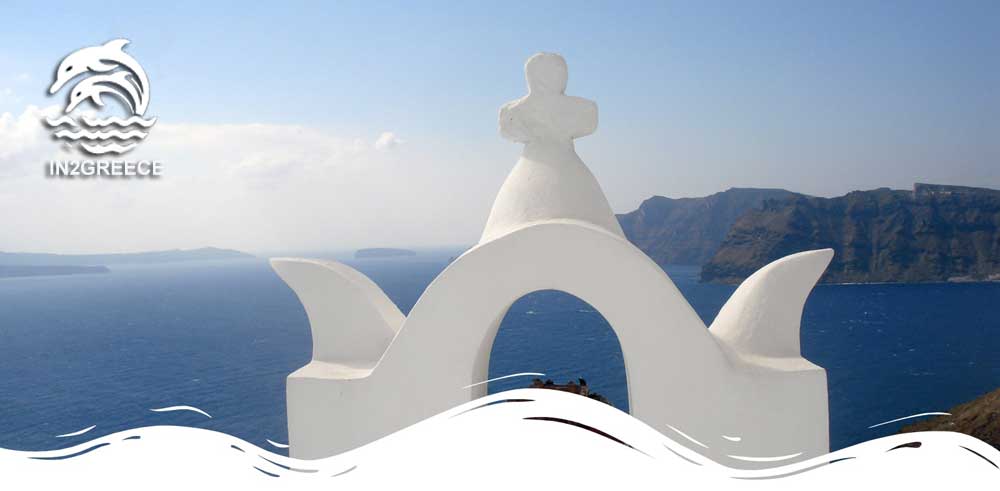Halkidiki travel guide
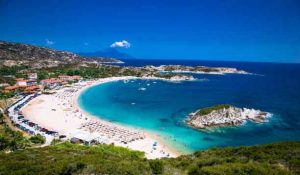
But the mountainous part also offers many opportunities for tours in the picturesque villages around the beautiful forests of Holomontas and Stratonikos. There are several islands nearby from the shores of Halkidiki, which are worth discovering by boat, with only inhabited Ammouliani, with shallow and calm shores.
Lovers of action will find more than 20 marked trails throughout Halkidiki and about 17 cycling routes, which pass through Holomontas and Natura protected areas, modern diving centers and water sports centers. The accommodation options are endless, from rooms to let and picturesque hostels, small hotels to famous, award-winning and luxury complexes. Finally, you will find variety in terms of food – from good family taverns to award-winning gourmet restaurants.
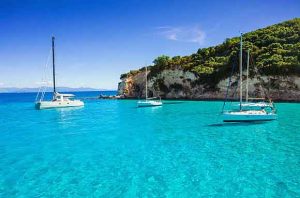
The peninsula of Mount Athos does not belong to the prefecture, but is an autonomous administrative area. Chalkidiki borders to the North with the Prefecture of Thessaloniki, to the west is bathed by the Thermaic Gulf, to the south by the Aegean Sea and to the east by the Strymonikos Gulf and the Thracian Sea. Halkidiki has an area of 2,918 sq. Km and a population of 91,654 inhabitants. The capital of the prefecture is Polygyros. Administratively it is divided into two provinces: Arnaia with Arnaia as its capital and Halkidiki with Polygyros as its capital
| Mountainus Halkidiki |
| History |
| Geography |
| Economy |
| What to See |
| What to do |
| Beaches |
| Nightlife |
| Eating out |
| Shopping |
| Getting around |
| Getting there |
Although lesser known, it is just as beautiful. Around the green Holomontas are many picturesque villages, with rich history, such as Paleochori, Neochori, Barbara and Stanos, while Arnaia is the most famous town, with old mansions – some of which have been judged to be preserved – and picturesque alleys. Around the village of Taxiarchis there are many forest routes for both hiking and mountain biking and 4×4. Traditional hostels (agritourism or not) offer pleasant and comfortable accommodation all year round. When to go An ideal time to enjoy the beautiful landscapes of mountainous Halkidiki is spring, when nature is at its best.
In Arnaia is worth visiting the Folklore Museum, which is housed in the mansion Giatradiko, the church of Agios Stefanos (the largest in the area) and the hill of Profitis Ilias for its panoramic view. Water saw At a distance of 20 km from Arnaia, in Neropriono you will find two beautiful waterfalls and in Retsini three early Christian churches.
If you are in the area of Stanos for Christmas, it is worth visiting this village on December 26, when the Gourounohares (or Hoirosfagia) are celebrated. Vrastama, this picturesque village of Holomontas is famous for its kumara tsipouro and on the 15th of August a big celebration for raki is organized here.
History
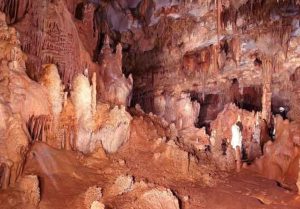
In Greek mythology, this is also described as a place of origin. When the giants or Titans revolted against the gods, this is were the battle took place. The gods won, and some of the Titans were buried under the three peninsulas of Chalkidiki. The ancient Greeks would call Cassandra “Flegra” (“Fireplace”) and that’s were the giants were born. Another name for it was Pallene, the daughter of the giant Sithonas who in turn have given his name to the second peninsula. The giant Engelados was buried under Cassandra, and every once in a while he tries to get out, causing the earth to tremble. To this day, the phrase “Engleados has struck” meaning “there’s been an earthquake” is used in modern Greek. Mt. Athos was named after the giant Atho.
Chalkidiki has a very rich history, starting in the Bronze age as a commercial centre, going through the Persians wars, and becoming part of the Macedonian empire. In the 2nd century BC the Romans invaded Greece and Chalkidiki was used as an important commercial and strategically foothold.
During the Byzantine empire Agios Oros started developing and the first monasteries were built. For a long time Chalkidiki was under Serbian rule.
In the 15th century it was conquered by the Turks, and they also used Chalkidiki as a centre for both financial and military activities.
The war of Independence started in 1821, and the people of Chalkidiki not only had to fight the Turkish oppressors, but was also threatened by Bulgaria. Chalkidiki was freed in 1912. Ten years later, the catastrophy of Asia Minor happened, when the Greek population of Turkey was chased out of the country, and many sought refuge here.
Geography of Halkidiki
Soil
The soil distribution of Chalkidiki is as follows: 24.7% lowland, 50.6% semi-mountainous and 24.7% mountainous. Its main feature is the large forest cover.
Mountains:
The main mountains of Halkidiki are: the southern part of Chortiatis (1,009 m.), Holomon (1,165 m.), Stratoniko (823 m.) And Itamos (753 m.).
Plains: Chalkidiki has small plains along its beaches and in a part of it to the north.
Rivers: There are no rivers in the Prefecture of Halkidiki. There are only torrents and streams: Vatounias, Kountouras, Kougioumelos, Platanos and Richios.
Coasts: Chalkidiki has the most diverse coasts of Greece. Their main feature is the smaller peninsulas that form.
Islands: In the gulf of Kassandra there are the islets of Helona and Spalanthronisia. In the gulf of Mount Athos there are the islets Diaporos, Kalogria, Ambolitsa, Agios Isidoros and Kalamonisia. In the bay of Provlakas there is the residential islet of Amoliani. At Cape Elefthero there are the islets of Eleftheronisos and Kafkanas.
Forests: Halkidiki has the largest forest cover of all the prefectures of the country. These forests are mainly composed of beeches and firs.
Climate
The climate in Halkidiki is Mediterranean, with mild winters and cool summers.
ECONOMY
The economy of Halkidiki is mainly rural. Main crops are cereals, tobacco, cotton and arboriculture. Livestock does not show much growth. The subsoil of the prefecture is rich in minerals and the mining industry is developed. Fishing is also developed in Halkidiki.
In the gulf of Ierissos there are fish farms with a large annual production. The main economic factor is also tourism. The prefecture, which is one of the most beautiful in the country, receives hundreds of thousands of visitors every year, with the result that a large part of the population is employed in the tourism professions.
WHAT TO SEE
CASSANDRA
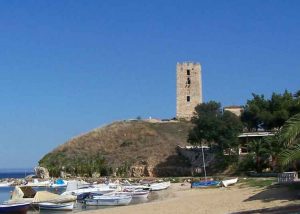
Nea Potideia has a castle where the rebellious Greeks would hide while fighting the Turks during the war of Independence. It also has an interesting church, Ag. Taxiarches.
In Kallithea you can visit the archaeological site where temples to Zeus and Dionysus stood.
The cave of Petralona is just outside the village of the same name, and is a stalactite cave where the 700 000 year old skeleton was found. There is an archaeological museum here were findings from the cave can be seen.
SITHONIA
Neos Marmaras has a monastery open to visitors called Tripotamus. You can also visit the Byzantine settlement Parthenon which today is deserted.
In Nikiti there are some very interesting churches. Amongst others, there is the chapel of St. Paul, the 5th century church of St. George, as well as a monastery.
Of course, these are just a few examples of interesting places. There are so many nice villages and sights here, that a complete site would be needed to cover them. It is a great experience to explore Chalkidiki, either by bus or by renting a vehicle.
WHAT TO DO
Halkidiki is a very big area, and apart from the many lovely beaches and villages, there are golf courses, tennis courts, beach volley tournaments as well as many happenings for children, like touring circuses.
There are also daytrips to places like Vergina, where the tomb of Philip II, father of Alexander the Great, was found in the seventies. You can also visit the archaeological site of Pella, the ancient capital of the Macedonians.
Thessaloniki is a big city, and perhaps that’s not a place you’d like to go during your summer holidays. It is an interesting place, though, with a big archaeological and Byzantine museum, many excavations going on, art galleries, clubs with or without live music, bars and restaurants. Excursions to Meteora are also offered, as well as daytrips to MT Olympus.
There are so many beaches in Chalkidiki that it would be a shame not to mention them all. Both Cassandra and Sithonia has long sandy beaches. Have a look at the map where the best known beaches are marked.
Chalkidiki has both quiet villages and more busy holiday resorts If you really want some clubbing, your best bets are probably Neos Marmaras on Sithonia, or Kallithea, Nea Potidea, Chanioti and Pefkochori on Cassandra Polygyros is the capital of Chalkidiki and also has many bars and clubs.
Just like anywhere else in Greece – the best taverns are those with lots of Greeks in them. You’ll find a wide variety of restaurants in Halkidiki, with international food in the larger towns, and many local specialities in the villages. Ask the waiter when you order, it might no be on the menu. All over there are locally made wines and sweets as well.
As with the food, many places produce their own speciality. You’ll find many shops in Polygyros and the larger summer resorts. In the villages there are usual smaller shops with local handicraft like textiles, wood carved objects and clothes.
Local buses can take you to almost all the villages and towns, and there are also cars and bikes for rent. See below for telephone numbers
The nearest airport is in Thessaloniki, and from there you can take a bus, which takes about 1,5-2 hours, depending on where you are going.
Towns and resorts of Halkidiki
IERISSOS
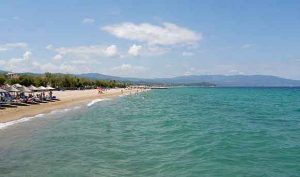
When to go: The best time is from spring to autumn.
What to see
Archaeological Site of Ierissos
Here was the rectory of Ancient Akanthos. Today, parts of the walls are preserved, among them an impressive part of the citadel, as well as scattered architectural members and buildings, mainly from the Classical and Hellenistic times. The extensive cemetery is located in the coastal zone of Ierissos and numbers around 9,000 graves.
Ancient Stageira
The homeland of Aristotle. The city was founded in 655 BC. from Ionian settlers of Andros. Here you will see the fortification of 500 BC, the citadel, the reservoir and the main water supply, the arcade where the market was located and parts of Hellenistic houses, as well as the Grove of Aristotle, where – except for his statue – there are also 10 instruments which show some of the natural phenomena to which refers in his book “Physics”
.
Tower of Krouna
It is located about 1 km northwest of Ierissos, surrounded by a damaged wall and dates from the 15th century. Today it is about 12 m high, while it is estimated that it lacks the top floor.
Aquarium
A beautiful aquarium has been operating on the beach since 2005, which hosts fish, seafood and shellfish from the bay (eg swallows, murmurs, skates, red mullets, sea urchins, lobsters, etc.).
Beaches
Most beaches receive a Blue Flag every year, which certifies the purity of the waters and the coast. On the way to Olympiada you will find Kouri (long sandy beach), Kakoudia,with impressive granite rocks in the sea, the green beaches of Gourgouros and Zepko, Proti Ammoudia, Vina, Kefala and Sykia.
POLYGYROS
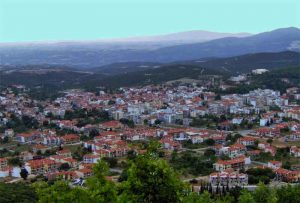
When to go
Mainly from spring to autumn but also the rest of the year. His carnival, which takes place on Shrove Monday, is a special experience.
What to see
Archaeological Museum
It presents findings from the most important archaeological sites of the prefecture, from the three colonies of Andros in Halkidiki, Stageira, Akanthos and Sani as well as the Lambropoulou collection (clay figurines and busts, bronze vessels, jewelry, etc., from Prehistoric up to the Byzantine period).
Folklore Museum
It is housed in the Karagani house and represents a traditional house of Polygyros at the beginning of the 20th century. Among the exhibits you will see traditional costumes, agricultural tools, etc.
Six Fountains
It is located in the city center and is a trademark of it. It’s exactly what his name describes!
Chapels
One kilometer outside the city you will find the famous chapel of Panagia and on the hill of Profitis Ilias the picturesque chapel of the same name: enjoy the magnificent view from the top of Tsoukalas (890 m.).
OURANOUPOLIS
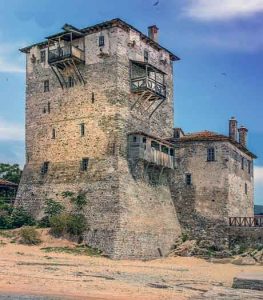
Cruises to the west side of Mount Athos are also organized. In Ouranoupoli you will find large and small hotel units, rooms to let, cafe-bars, restaurants and shops. For nature lovers there are beautiful walking paths between olive and pine trees.
Ammouliani and Drenia are small islands which you can visit through regular itineraries from Ouranoupolis or by renting your own boat. From there start ships that make day cruises on the west side of Mount Athos.
What to see
Tower of Prosforios
This is the most characteristic point of Ouranoupolis. The tower of the monastery architecture was built before 1344 and the monks who took care of the monastery of Vatopedi Monastery, to which the whole area belonged from 1018 until the Asia Minor Catastrophe, lived here, when the estates were distributed to the refugees.
Beaches
Crystal clear beaches, awarded with a Blue Flag, are located very close to Ouranoupolis, such as those of Xenia, Kamboudi, Aristotle, Agios Pavlos and others. On the other side, on the border with Mount Athos, is the beach of Tarsana, which was named after the monastic shipyard located here.
